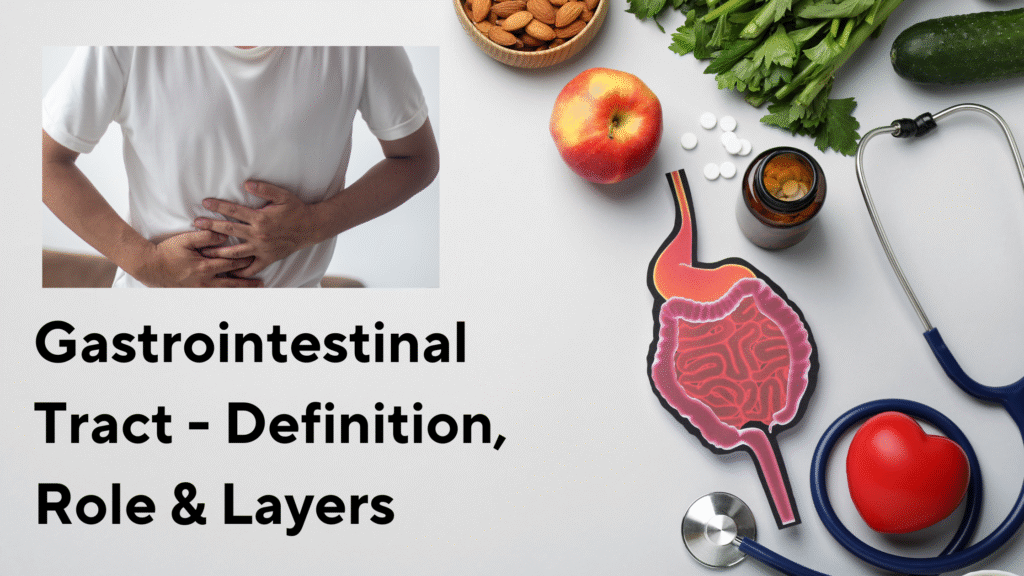What is the Meaning of (GI) Gastrointestinal Tract
The gastrointestinal (GI) tract, also known as the digestive or alimentary tract, is a part of the digestive system and has a connection from the mouth to the anus. The digestive system of the human body and animals contains organs, including the mouth, esophagus, stomach, small intestine, large intestine, rectum, and anus. These organs transport liquids and foods through the body when they are swallowed, digested, and absorbed. Overall, you can understand that the food is consumed from the mouth. After digesting all the nutrients and having energy, this food is out as a waste from the anus as feces.
What is the Digestive System?
The role of your digestive send is to send food through your body so that the organs of your body can work and get the nutrients to support good health and well-being. Your body digest the food and liquid with the help of following steps:
- When you keep an eye on food and smell it, your salivary glands first work and they produce saliva so that you can moisten the food with your spit and start chewing.
- The next step is chewiing. When you chew your food, it travels from your mouth to esophagus that furthers move food to your stomach.
- Your stomach produces enzymes and acid that help the food break down.
- The next step is to turn the semisolid food into fluid from your small intestine and help your body absorb nutrients.
- Small intestine take digestive juices from liver and pancreas and the bile produces from your gallbladder.
- The leftover food from your your small intestine moves to large intestine as waste and this waste further becomes poop that you release from your butthole or anus.
Role of the Digestive System and Why It Is Important
The role of the digestive system is to break the eaten food or drinks into smaller parts and, after that, move this liquid or food through your GI tract, meaning moving this food from the mouth to the anus as waste. Breaking down the food is essential to help your body get sufficient nutrients and transfer these nutrients to where they are required. Your hormones and nerves help in controlling the digestive process. The large intestine absorbs water, and after it is digested, the waste products become stool. In order to stay healthy, it is essential to digest the food or nutrients properly. Otherwise, your body will not work, and you will feel sick. The role of the digestive system is not only to break down nutrients into parts; it also helps you grow and generate energy and work on your cell repair. Examples of nutrients are carbohydrates, fats, proteins, and minerals. Protein aims to break into amino acids. Carbohydrates split into simple sugars, and fats break into glycerol and fatty acids.
Four Concentric Layers of the GI Tract
The gastrointestinal (GI) tract comprises four concentric layers: Mucosa, Submucosa, Muscular Layer, and Serosa. The structure of these layers can vary based on their function and the digestive system of different regions.
1. Mucosa
The innermost layer of the GI tract is the mucosa. It consists of an epithelial lining supported by an underlying layer of loose connective tissue, also known as glandular tissue. This tissue supports the epithelium and contains mucosal glands. Plasma cells and lymphoid follicles are also present within the mucosa, where digestion products travel into the capillaries.
2. Submucosa
The submucosa is a dense layer of connective tissue contains lymphatics, blood vessels, mucous-secreting glands, and nerves. is a dense layer of connective tissue located beneath the mucosa. It contains nerves, and mucous-secreting glands. This layer provides structural support and facilitates the transfer of absorbed nutrients.
3. Muscular Layer
The muscular layer, also called the muscularis propria, consists of two sublayers:
- Inner Circular Layer: Circular in shape, responsible for constricting the lumen.
- Outer Longitudinal Layer: Oriented longitudinally, shortens the tract.
Together, these layers produce coordinated contractions (peristalsis) that move food through the digestive system.
4. Serosa
The serosa is the outermost layer of GI tract and also called the adventitia in some regions. Its connective tissue layer is covered by a simple squamous epithelium. The serosa lowers friction as the digestive organs move and expand within the abdominal cavity.






